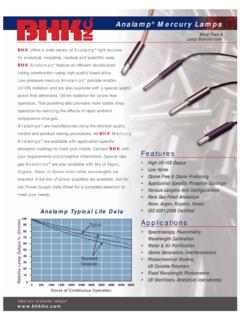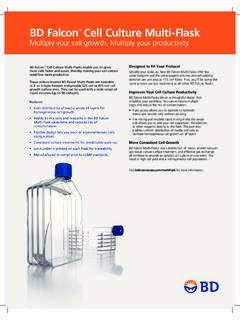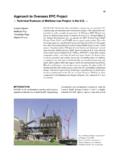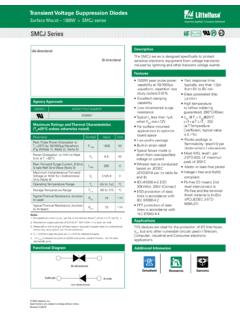Transcription of Veterinary vaccines and their use in developing …
1 Rev. sci. tech. Off. int. Epiz., 2007,26(1), 179-201 Veterinary vaccines and their use in developing countriesJ. Lubroth(1), Rweyemamu(2), G. Viljoen (3), A. Diallo(3), B. Dungu (4)& W. Amanfu(1)(1) Animal Health Service, Food and Agriculture Organization (FAO) of the United Nations, IDGE-EMPRES,Animal Production & Health Division, Viale delle Terme di Caracalla, 00100 Rome, Italy(2) Royal Veterinary College, University of London, United Kingdom (3) Animal Production and Health Subprogramme, Joint FAO/IAEA Programme of Nuclear Techniques in Foodand Agriculture, Department of Nuclear Sciences and Applications, International Atomic Energy Agency,Vienna, Austria(4) Onderstepoort Biological Products, Pretoria, South Africa SummaryThe burden of infectious diseases in livestock and other animals continues to bea major constraint to sustained agricultural development, food security, andparticipation of developing and in-transition countries in the economic benefitsof international trade in livestock commodities.
2 Targeted measures must beinstituted in those countries to reduce the occurrence of infectious Veterinary vaccines used strategically can and should be part ofgovernment sanctioned-programmes. Vaccination campaigns must be part of comprehensive disease control programmes, which, in the case of transboundary animal diseases, require a regional approach if they are to besuccessful. This paper focuses on the salient transboundary animal diseasesand examines current vaccine use, promising vaccine research, innovativetechnologies that can be applied in countries in some important developingregions of the world, and the role of public/private Biotechnology Bluetongue Brucellosis Contagious bovinepleuropneumonia Foot and mouth disease Mycoplasma Rift Valley fever Vaccination growing demand for livestock products (fuelled bypopulation growth, increased urbanisation and greaterpurchasing power of individuals in developing or middle-income countries) coupled with the necessity of complyingwith the standards of trade agreements, mean thatgovernments must improve animal health in theircountries, particularly as it relates to infectious diseasecontrol (27, 28, 40)
3 , limits on residues in commodities,and animal welfare (13). Recent assessments show thatinfectious diseases will continue to be a major constraint tosustained international exports in livestock commoditiesfrom developing countries unless targeted sanitarymeasures are instituted in those countries to reduce theburden of these diseases (68). This paper addressesvaccines for selected epidemic diseases of livestock,examines historical and current trends for prophylaxis toimprove animal production in the high-risk and endemicareas, and highlights some opportunities and recentadvances in vaccine research. Excellent vaccines used in aless than optimal vaccination strategy will fail to truly curbthe incidence of disease. Furthermore, transboundaryanimal disease containment and control (for eventualeradication) require regional approaches and buy-in fromthe public and private sector (including smallholders thatraise animals to meet their own needs), but developingsuch regional vaccination strategies based on quality,effective vaccines requires well equipped and proficientdiagnostic laboratories linked to reliable veterinaryepidemiological units.
4 vaccines and vaccination mustcomplement other aspects of disease prevention and control, namely, enabling legislation, open and risk-based surveillance, diagnostic proficiency, early response,transport and market regulations, compliance, and vaccines for selectedtransboundary animal diseasesAll transboundary animal diseases, including thoseselected for discussion here, have the following definingcharacteristics: they are of significant economic, trade and/or foodsecurity importance for a considerable number of countries they can easily spread to other countries and reachepizootic proportions their control and management, including exclusion,requires cooperation among neighbours, whether these belocal, provincial, national, or regional (44). vaccines for livestock offer an important and, at times, anessential tool for progressive control of a giventransboundary animal disease, but they requirecomplementary actions: enabling legislation surveillance investment for diagnostic proficiency and capability early response coordination among several agencies management of livestock transport mechanisms market inspection and hygiene compliance public and mouth disease Foot and mouth disease (FMD), a highly contagious viraldisease of mammals of the order Artiodactyla, is stillconsidered globally as one of the most economicallyimportant diseases and is a threat to livestock productionand agricultural development.
5 Despite the fact that thereare numerous viruses (serotypes) that cause clinical diseasecharacterised by a variety of lesions and a drop inproductivity, the most important aspect of FMD is itsimpact on trade in animals and animal products (8, 61, 93).Since the beginning of the 21st Century, FMD has occurredin almost two thirds of the Member Countries of the WorldOrganisation for Animal Health (OIE), either in anepizootic or enzootic form, causing varying degrees ofeconomic losses. However, some of the major livestock-producing regions of the world, including North America,Western Europe, Oceania and some parts of South Americaand Asia, are recognised as free of the disease at to increased global trade and movement, FMD hasshown great potential in recent years for sudden andunanticipated international spread. The evolution of thepandemic Pan-Asia strain of type O FMD virus in recentyears and the introduction of SAT types to the ArabianPeninsula are good illustrations (61, 93).
6 The epidemiology of FMD is characterised by the relativestability of the virus, its ability to survive outside livinganimals, the rapid growth of the virus, the small quantitiesof virus required to initiate the infection, the existence ofasymptomatic carriers and, in sub-Saharan Africa, thepersistence of the infection in wildlife (61, 93).The first FMD vaccine , developed in 1938 by Waldmannand K be, was based on formaldehyde inactivated virusharvested from tongues of artificially infected cattle,collected at the height of the clinical disease and adsorbedon aluminum hydroxide. The large-scale production of theFMD vaccine started with the Frenkel vaccine in the late1940s, using bovine tongue epithelium collected fromabattoirs as in vitro culture system. Although this approachlasted through the early 1990s, one of its majordisadvantages was the inability to guarantee freedom frombacteria or yeast or any form of contamination (8), norguarantee the standardisation of the primary amplificationmechanism ( primary culture versus cell culture).
7 The finding, by Mowat and Chapman in 1962, that FMDvirus could multiply efficiently in a baby hamster kidney(BHK) cell line opened the door to the cell-basedproduction of FMD vaccine in suspension and monolayercultures (8). vaccines currently used against FMDthroughout the world, including Africa and SouthAmerica, often contain one or more serotypes that havebeen grown in large volume in BHK cell culture and theninactivated using aziridine compounds (usually binaryethyleneimine) (2, 31, 86). The virus harvest is thenconcentrated and formulated with an adjuvant (eithersaponin/aluminum hydroxide gel or various oil emulsions)to potentiate the immune response of the host. Suchvaccines have been used successfully for decades toeradicate FMD in different parts of the has proven to be a very effective way ofcontrolling and eliminating FMD from certain regions ofthe world, such as Western Europe and parts of SouthAmerica (58, 86).
8 Different forms of vaccinationprogrammes are implemented in different regions of thedeveloped world, with varying challenges to their key challenge is the availability and high cost of thevaccine. Because the vaccine needs to contain a largequantity of specific antigen (1 g per dose or perhapscloser to 5 g per dose) and the production of largevolumes of FMD virus needs to be conducted in abiosecure facility that will prevent virus escape into theRev. sci. tech. Off. int. Epiz., 26(1)180environment, they are expensive to produce. Mostproduction plants are owned by multinationalbiopharmaceutical companies, usually driven by profitrather than disease control or eradication , the duration of immunity induced is shortand booster inoculations need to be administered at 4 to 6monthly intervals in most animals, including young swine, aqueous-based vaccines are ineffective, and theapplication of oil-based technology to protect swine andprolong immunity to bovids ( boosters every 6 to 12months) offered great advantages in the 1980s when firstapplied widely in South America.
9 Oil-based FMD vaccineshave been shown to be very effective as emergencyvaccines for pigs (34, 85).Another challenge in the control of FMD is the debatablesituation of asymptomatic carriers : ruminants vaccinatedagainst FMD may be protected from developing clinicaldisease but are not necessarily protected from infection andsome vaccinated animals may become persistently infectedfollowing challenge (1). However, the preciseepidemiological role of the persistently infected animal inthe maintenance of the disease and their responsibility fordisease outbreaks in susceptible species has been an issueof much debate over the past 80 years. The epidemiologyof FMD in endemic regions of sub-Saharan Africa hasunique features that render the control of the diseaseextremely complex: firstly, the prevalence of six of theseven FMD serotypes and secondly, the reservoir roleplayed by wildlife, mainly free-living African buffalo(Syncerus caffer) populations infected with the three SAT-types of FMD virus, SAT1, SAT2 & SAT3 (99).
10 Little isknown about the sylvatic maintenance of the virus in Asiaand South significance of viral diversity (and thus antigenicdiversity) as a complicating factor in effective vaccinationagainst FMD in Africa is frequently ignored. Immunity isinduced only to virus serotypes and subtypes included inthe vaccine . In addition to the large number of serotypesprevalent on the African continent, sub-Saharan Africa isthe only region of the world where the SAT serotypes ofFMD virus are endemic, with widely distributed serotypesO and A, and serotype C being detected in Kenya. SAT2(102), SAT1 (10) and serotype A (57) have been shown toharbour considerable nucleotide sequence diversity, givingrise to lineages with >20% sequence divergence. Thesedivergences have been shown to be associated withconsiderable geographically based antigenic variation (98),corresponding to different topotypes within the occurringserotypes.
















